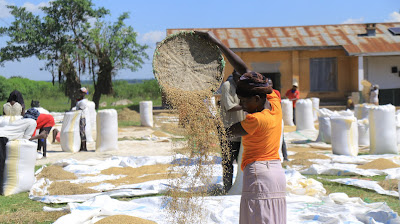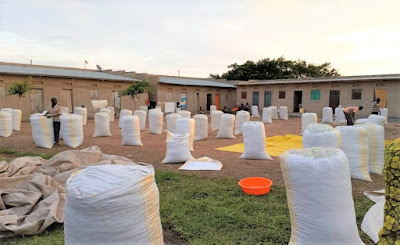Ministry of Agriculture, Animal Industry and Fisheries Press Statement: Outbreak of Desert Locusts in the Eastern Africa Region
Introduction
The second
half of the year 2019 recorded unusually high rains in most parts of Eastern
Africa that had not been seen in many years. These rains incidentally fell also
in the semi-arid traditional Desert Locusts (Schistocerca gregaria) breeding
ecological areas of Sudan, Ethiopia, Eritrea, and Somalia. The favourable
conditions facilitated further locusts breeding, multiplication and spread into Kenya.
Facts about
the Desert Locust
Desert Locust (Schistocerca gregaria) is a species of short-
horned grasshopper family. It is characterized by its nature of high mobility
(migratory) and broad-spectrum feeding habits.
Locust Status/ Phases
Locusts have the ability to alter their behavior, color, size, and shape. When the population density is low, locusts behave as individuals,
when the population is high, they swarm and migrate. The locust life cycle
comprises three stages of egg, hopper, and adult and it lives a total of three
to six months.
Locust ecology and behavior
In Solitary phase, the Desert Locust lives individual life
until it rains with the availability of vegetation, the females lay eggs. Desert
Locusts usually fly with the wind and swarms can travel between 5-150 km or
more a day depending on weather conditions and normally taking off 2-3 hrs after
sunrise in warm weather and 4-6 hrs in cool weather.
Locust feeding habits
Locust swarms vary from less than one km2 to several hundred
km2. There can be at least 40 to 80 million locusts per square kilometer of swarm.
Coupled with its amazing ability to build up and multiply to colossal numbers,
a locust can eat its own weight in fresh food (about 2 gm/day). Half million
locusts weigh about 1 ton and they can eat about one ton of food enough to feed
2500 people.
2.Current
situation and control operations in Kenya
By October 2019, the Desert Locust situation had
worsened in Ethiopia, Sudan, Eritrea, and Somalia and the governments had
instituted aerial spray control operations with support from Desert Locust
Control Organization for Eastern Africa and other Development partners. As
earlier predicted by FAO experts, the Locusts invaded North Eastern Kenyan
County of Mandera by December 2019. Currently by (9th January,2020) they have
spread to the six Counties of Mandera, Marsabit, Wajir, Garissa, Meru and
Isiolo. The Kenyan government working with Desert Locust Control Organization
for Eastern Africa and partners has instituted control operations to suppress
the population and stop further spread.
3. Further
outlook
Due to the security situation in Somalia and North Eastern Kenya (Mandera and
Garissa Counties) and other factors, there are still large locusts’ swarms
observed from Somalia and Ethiopia with further spread inside Kenya.
Since the current control capacity is limited, some of the swarms could move
further Western into Turkan county, probably by Mid January 2020, with likely
potential and risk that some swarms could spill over into the North Eastern
region of Uganda, particularly Karamoja region (borders Turkana County).
4.Interventions by the Ministry of Agriculture Animal Industry and Fisheries – Uganda
a)
Uganda is a member of the Desert Locust Control
Organization for Eastern Africa and is currently closely working and sharing
information on the current status of the desert Locust in the Region.
b)
A technical team of Two officers have been
assigned to travel to Kenya (Wajir and Marsabit counties) to understudy the
current Locust control operations to subsequently share experiences and support
the control efforts in Uganda (in case of any outbreak).
c)
MAAIF has communicated to MOFPED to make good of
the arrears on Annual contributions to DLCO EA which currently stand at US $
5,090,000 as of June 30, 2019. This is in cognizance and appreciation of the
current pressure on the DLCO EA operation.
d)
The Ministry has communicated to office of the
Prime minister on the imminent Locust invasions and requested MOFPED for
provision of a contingency fund of 5 bn ug. Shillings to cater for aircraft
fuel (aircraft to be provided by DLCO EA), pesticides for control, provide for
ground spray equipment and spray teams and to continuously create awareness to
the population in case of an invasion.
e)
The Ministry has alerted all the Districts in
Karamoja and entire Eastern Region to be on the lookout and the public to
report immediately to the nearest Extension Staff in case of any strange
grasshoppers detected in their areas.
5.Conclusion
The Ministry of Agriculture, Animal Industry and Fisheries requests the country not to panic because we are now vigilant following up developments and control efforts in Kenya. In case of any outbreak, we are ready to handle it.
For God and my County
Hon. Bagiire
Aggrey
Minister of State for Agriculture, Animal Industry and Fisheries.
Minister of State for Agriculture, Animal Industry and Fisheries.
10th January 2020
Crossposted from https://ugandamediacentreblog.wordpress.com/2020/01/10/statement-outbreak-of-desert-locusts-in-the-eastern-africa-region/




Thanks Hon. Minister for the alert. We request more and close involvement of MAAIF officials towards monitoring and supervision of all strategized programs for development.
ReplyDelete